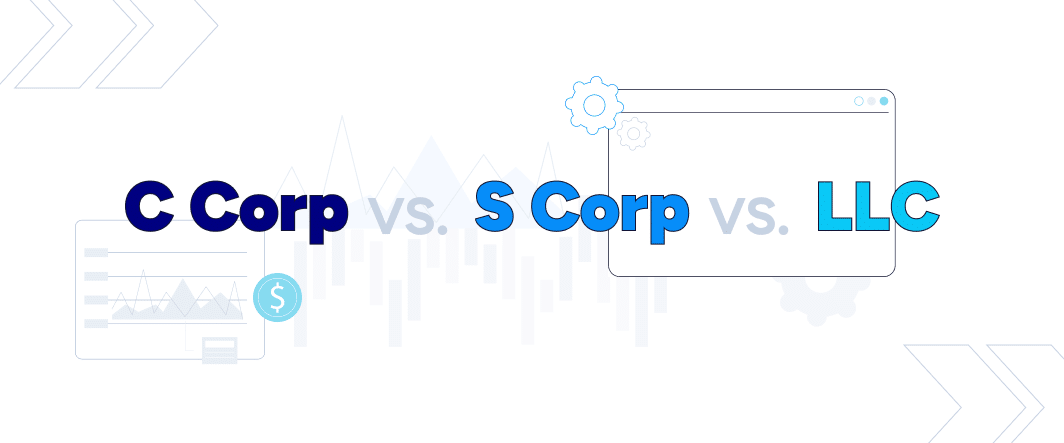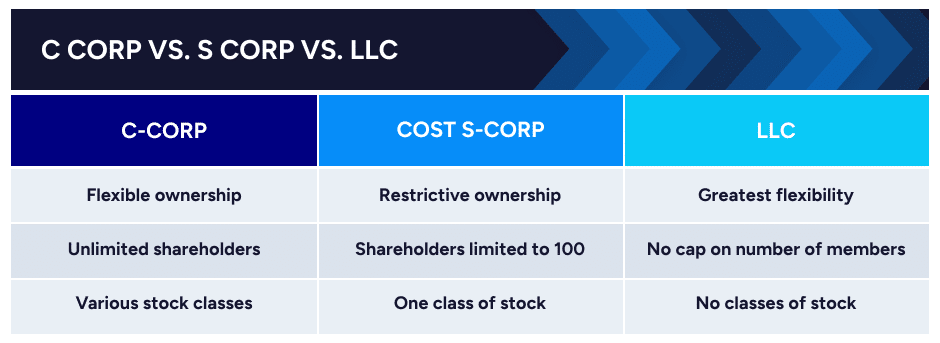C Corp vs. S Corp vs. LLC: Essential Information for Software Executives

Choosing the correct corporate structure is vital for software executives who want to optimize tax efficiency and prepare for potential M&A exits. The decision between forming a C Corp, S Corp, or LLC can significantly affect your company’s tax obligations, flexibility in ownership, and attractiveness to investors. Many of our clients are LLCs, but all three structures offer pros and cons to consider.
This blog post will explore the key differences among these structures to help you make an informed choice for your software company.
- C Corp vs. S Corp vs. LLC: How Do They Compare?
- Limited Liability Protection
- Ownership Flexibility & Restrictions
- Are C Corps Ideal for Software Companies?
- C Corp Tax Implications
- C Corp Ownership Flexibility
- Are S Corps Ideal for Software Companies?
- S Corp Tax Implications
- S Corp Ownership Restrictions
- Are LLCs Ideal for Software Companies?
- LLC Tax Implications
- LLC Ownership Flexibility
- How to Choose Between C Corp vs. S Corp vs. LLC
- The Next Step in Optimizing Growth
C Corp vs. S Corp vs. LLC: How Do They Compare?
While significant tax differences exist among them, C Corps, S Corps, and LLCs share some standard features to know before digging into comparison details.
Limited Liability Protection
All three structures—C Corp vs. S Corp vs. LLC—offer limited liability protection, meaning your personal assets are generally protected from the company’s liabilities. If your business faces financial difficulties, creditors typically cannot pursue your personal assets to satisfy business debts.
Ownership Flexibility & Restrictions
- C Corps: C Corporations offer ownership flexibility, allowing unlimited shareholders and various classes of stock. This is why public companies are almost always C Corp.
- S Corps: S Corps are more restrictive, limiting shareholders to 100, all of whom must be U.S. citizens or residents, and allowing only one class of stock.
- LLCs: LLCs offer the greatest flexibility in ownership, with no cap on the number or type of members, which can include individuals, corporations, and other LLCs.

Are C Corps Ideal for Software Companies?
C Corp structure is the default for corporations. If you file Articles of Incorporation with your state, your business will become a C Corp. Let’s look at the primary ways that would affect your software company.
C Corp Tax Implications
One of the defining tax features of C Corporations is “double taxation.” It refers to the fact that C Corp profits are taxed twice: first at the corporate level, then again at the personal level when shareholders receive dividends.
More specifically, C Corporations owe a flat 21% tax on their annual net earnings at the federal level. When they pay out those same funds as a dividend, their shareholders also owe progressive taxes of up to 37% on the amount.
Some tax experts have their clients elect S Corp or LLC status to avoid double taxation, but there’s much more to consider if you’re interested in any type of M&A exit. C Corporations have significant advantages that can outweigh the drawbacks of double taxation.
Most notably, only C Corp shares qualify for the QSBS exclusion that lets you shelter up to $10M of capital gains from federal taxes. However, to benefit from QSBS, your C Corp shares must meet certain requirements:
- Original issuance: You generally must have acquired the stock at its original issue in exchange for cash or services provided to the C Corp.
- Active business: The C Corp must use 80% or more of its assets to conduct a qualified trade or business. Fortunately, software companies should qualify.
- Gross assets: The C Corp must have had gross assets of $50M or less when it issued your shares.
Assuming your shares meet these QSBS requirements, you must hold them for at least five years to exclude your gains on the sale. However, if you dispose of them early, you may be able to defer your gains by rolling over the funds into other QSBS shares.
All in all, the QSBS rules provide founders and other shareholders with huge tax-free or tax-deferred benefits. If you meet the qualification requirements, you’ll have incredible opportunities for tax savings when you execute your M&A exit.
C Corp Ownership Flexibility
When it comes to ownership flexibility, C Corporations are unrivaled, with virtually no restrictions that could limit their growth. For example, here are some of their most significant advantages:
- Unlimited shareholders: There’s no cap on the number of shareholders a C Corp can have, which is why public companies are almost always C Corps.
- All owner types allowed: Any entity can own C Corp stock, including foreign and domestic individuals, C Corps, S Corps, LLCs, and trusts.
- Multiple stock classes: C Corps can issue more than one type of stock to grant shareholders different economic privileges, such as a higher claim to assets and earnings in case of liquidation.
This flexibility is attractive to certain investors and can be beneficial when you wish to secure equity financing or sell your software business.
Are S Corps Ideal for Software Companies?
Interestingly, there’s no way to create an S Corp from scratch. Instead, you have to create an LLC or a C Corp first, then file Form 2553 to request S Corp tax treatment. Let’s explore the impact of making that election for your software company.
S Corp Tax Implications
One common reason to elect S Corp status is to avoid double taxation. S Corps are pass-through entities, which means they don’t owe taxes at the corporate level.
Instead, each shareholder reports their share of the S Corp’s profit or loss on their personal tax return and pays ordinary income taxes on the amount. They can also take additional payments from the company called “distributions.”
Distributions are a bit like dividends, but they’re tax-free as long as the shareholder has “stock basis” in their S Corp. That essentially means they’ve put more money into the company than they’ve taken out, either via contributions or undistributed profits.
Another major advantage to filing as an S Corp is that it makes it feasible for sellers to structure M&A deals as asset sales. Among other benefits, this allows buyers to get a step-up in basis when they acquire your company.
In other words, they could get to use each asset’s fair market value on the acquisition date to calculate depreciation and future gains or losses, rather than your cost basis. That can lead to serious tax savings, so many private equity buyers prefer to acquire S Corps using F reorganizations, which may offer higher valuations for them.
Of course, filing as an S Corp has several other major tax implications for software companies, including:
- QBI deduction: S Corp shareholders can write off 20% of their business income from a qualified trade or business.
- Net loss deductions: If your S Corp generates a net loss, you can potentially use it to offset your income from other sources.
- QSBS disqualification: As mentioned previously, S Corp shares don’t qualify for the QSBS exclusion, even if you meet the other requirements.
Ultimately, C Corp vs. S Corp. vs. LLC each have opportunities for significant tax savings during your eventual exit. Which corporate structure will be more lucrative depends on your circumstances and strategy.
S Corp Ownership Restrictions
In contrast with the ownership flexibility mentioned in the last section, S Corps have several ownership restrictions. Here are the rules you must follow to file as an S Corp:
- Issue only one class of stock
- Have no more than 100 shareholders
- Shareholders may not be partnerships, corporations, non-resident aliens, or certain trusts
These limitations can make S Corps incompatible with certain goals. For example, because they can’t have more than 100 shareholders, they’re incapable of going public.
Keep in mind, you can also unintentionally convert an S Corp to a C Corp or LLC by breaking these ownership requirements. Not only does that have tax consequences, but it can also make your exit trickier to navigate, especially if it’s discovered late. Make sure you can commit to following the rules if you elect S Corp status.
Are LLCs Ideal for Software Companies?
Unlike S Corps or C Corps, LLCs (Limited Liability Companies) offer a unique blend of flexibility and simplicity that may appeal to software founders. While LLCs aren’t corporations, they provide many of the same benefits, particularly when it comes to liability protection and tax options.
LLC Tax Implications
LLCs are pass-through entities by default, meaning the company itself does not pay federal income taxes. Instead, profits and losses are reported on the owners’ personal tax returns, allowing them to avoid corporate taxes. This setup is similar to S Corps, but LLCs offer even more flexibility.
If your business needs change, you can elect to have your LLC taxed as a sole proprietorship, partnership, S Corp, or C Corp, depending on what best suits your goals. For example, if you’re considering bringing on investors or preparing for an M&A exit, you might choose to be taxed as a C Corp to access certain benefits, like the QSBS exclusion.
However, it’s important to note that while this flexibility is a significant advantage, LLCs do not qualify for QSBS benefits, similar to S Corps. This limitation might influence your choice if you’re looking to maximize tax-free gains on a future exit.
LLC Ownership Flexibility
One of the standout features of LLCs is their flexibility in ownership. LLCs allow for an unlimited number of members, who can be individuals, corporations, or other entities, including foreign individuals and businesses. This flexibility makes LLCs a popular choice for startups and growing businesses that may need to adapt quickly to new opportunities or investors.
If you’re operating an LLC and considering an eventual exit, it’s crucial to ensure that your ownership structure is well-defined and documented. This will make it easier to transition to a C Corp or S Corp if necessary, or to navigate the complexities of an M&A deal within the LLC framework.
Ultimately, LLCs provide an attractive option for software founders who prioritize flexibility and simplicity in their business structure. Whether this is the best choice for your company depends on your long-term goals.
How to Choose Between C Corp vs. S Corp vs. LLC
As you can see, each structure has unique implications for taxes, ownership, and M&A potential. There’s no one-size-fits-all answer, and the best choice depends on your specific business goals, growth plans, and exit strategy. In addition, tax rules are always subject to change, so there’s no guarantee today’s best option will make the most sense tomorrow. For example, the 2025 Presidential Budget includes proposals that would:
- Increase the C Corp tax rate from 21% to 28%
- Disallow tax deductions for C Corp employee compensation beyond $1M
- Raise the corporate alternative minimum tax rate (CAMT) on $1B+ C Corps from 15% to 21%
Ultimately, you should select the corporate structure you believe has the best chances of minimizing your lifetime tax liability while facilitating your long-term goals, such as venture capitalist or IPO aspirations.
If you’re trying to determine whether a C Corp vs. S Corp vs. LLC is right for your software company, we highly recommend consulting with a Certified Public Accountant or other tax expert. They can help you forecast taxes in multiple potential scenarios and develop an informed strategy for your business.
The Next Step in Optimizing Growth
As you establish strategies for your growing business, pricing plays a pivotal role in its success and getting it right from the outset is crucial. A well-thought-out pricing strategy can act as a powerful driver of growth at this stage, but it requires a deep understanding of how to plan and implement pricing changes effectively.
In our Pricing Strategy Webinar, two industry experts break down essential pricing strategies, including:
- Why pricing is a key growth lever and how it directly influences company valuation.
- How to strategically plan and implement pricing changes for maximum impact.
- What key metrics to monitor and how to leverage pricing adjustments to drive improvements in those metrics.









